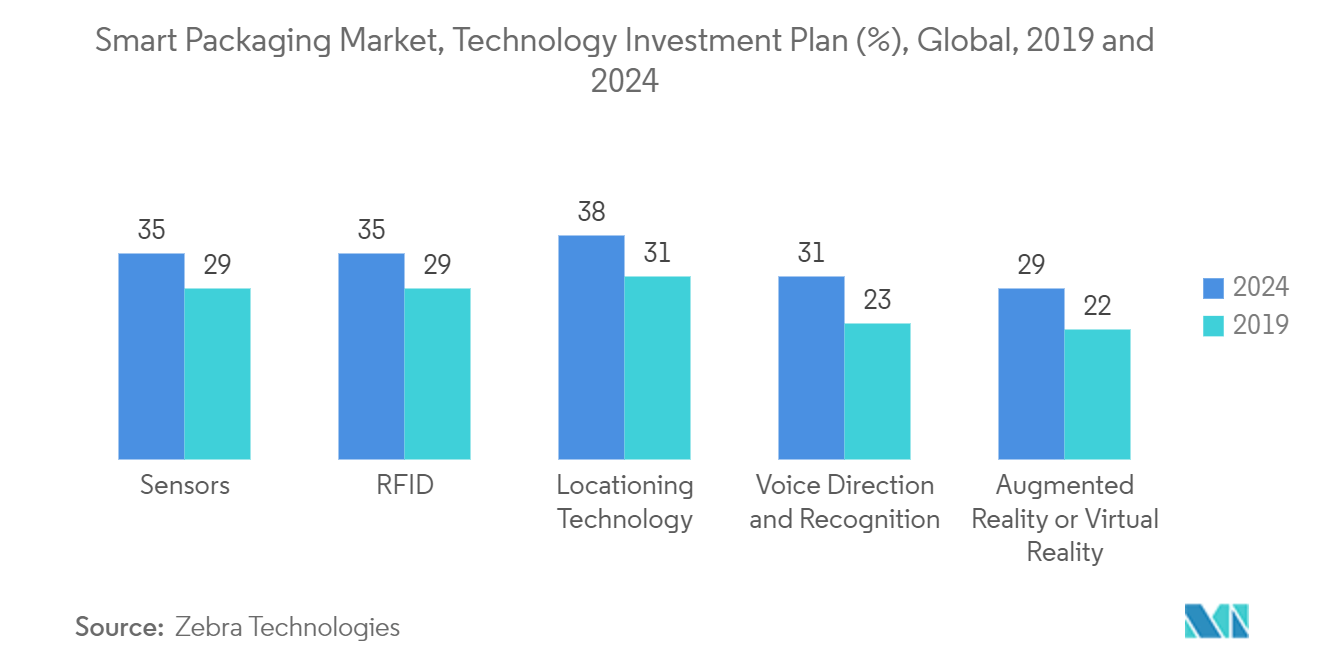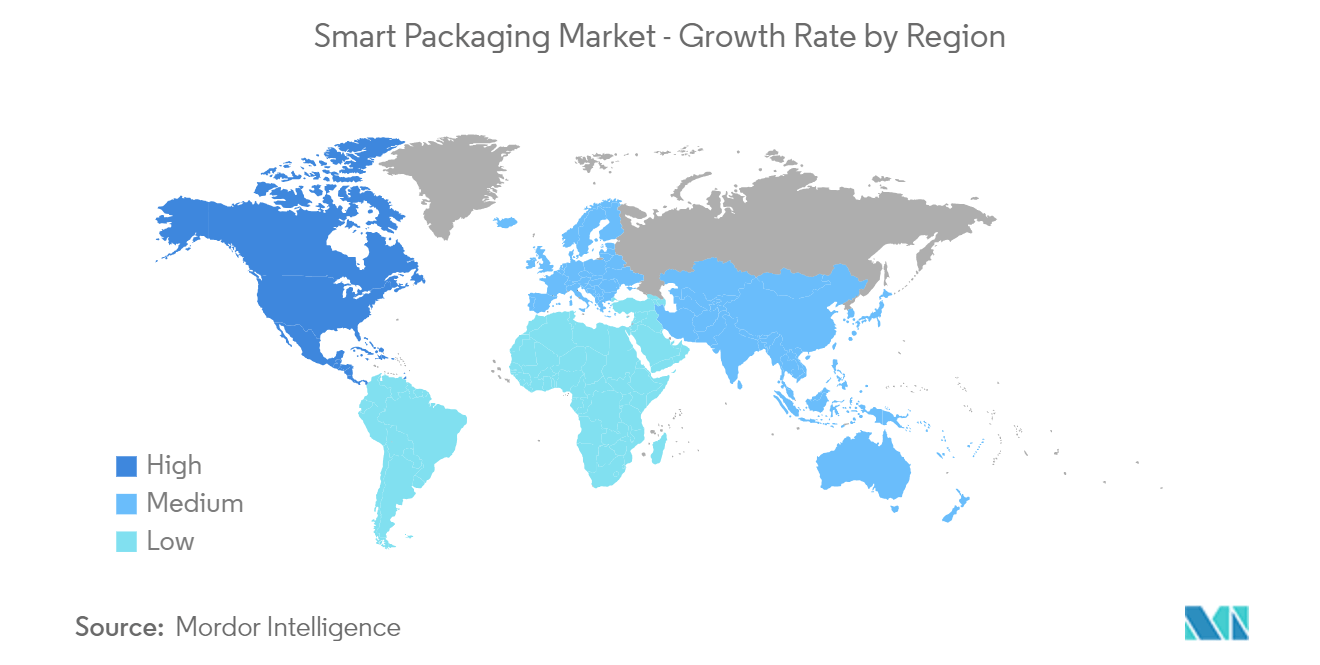Market Trends of Smart Packaging Industry
Active Packaging is Expected to Hold a Significant Market Share
- Active packaging technology builds on the traditional concept of packaging by adding functionality to the packaged product, adapting its mode of action to the protective function and needs of the product, and going beyond mere containment, protection, and transmission to limit destructive processes. Active packaging offers a new approach to reducing food waste and loss during increased demand in the supply chain.
- Companies are leveraging smart active packaging to differentiate their products in the market, offering innovative features that enhance user experience and perception of their brand. For instance, in January 2024, NPP completed the acquisition of Active Packaging Limited. Active Packaging, based in Omagh, is a business with a 21-year history supplying various flexible packaging materials to the food, horticultural, and industrial sectors throughout Ireland. With this acquisition, NPP aimed to leverage the strengths of both entities to deliver enhanced and diversified packaging solutions to its customers.
- In January 2024, ProAmpac, a player in flexible packaging and material science, announced the launch of ProActive Intelligence Moisture Protect (MP-1000), a patent-pending breakthrough moisture-adsorbing technology that eliminates the need for desiccant packets. MP-1000 platforms use Aptar's CSP Technologies' 3-Phase Activ-Polymer platform technology to lower the moisture level in the packaging headspace, making it ideal for applications that require optimal moisture control, such as point-of-care diagnostic kits, live culture probiotics, and hygroscopic powdery food products. This collaboration aims to transform how active packaging is delivered and fulfill unmet needs by providing a fully integrated, multi-layer film solution that is flexible and powered by CSP's proven Activ-Polymer technology. Such innovations drive the growth of the active packaging segment.
- Increasing demand for security and tracking solutions drives the growth of the segment. For instance, RFID tags provide the ability to identify, control, and manage the food supply chain. These are more advanced, reliable, and efficient for food traceability than conventional barcode tags. RFID tags for monitoring the products' temperature, relative humidity, pressure, pH, and light exposure are available in the market, aiding in enhancing food quality and safety. In October 2023, Fresenius Kabi announced the introduction of +RFID smart labels for Diprivan (Propofol) Injectable Emulsion, USP, 200 mg per 20 ml in single-dose vials, sold in the United States. The +RFID labels are fully compatible with all significant US RFID kit and tray systems.
- Additionally, Zebra Technologies Corporation, a US manufacturing company, reported that, by 2024, the market-leading packaging manufacturers and end users will likely gravitate toward incorporating more comprehensive technology integrations in warehousing management. According to the Warehousing Vision Study report by Zebra Technologies, the investment in technologies in warehousing, including RFID, sensors, and augmented reality, is expected to increase from 29%, 29%, and 22%, respectively, in previous years to 35%, 35%, and 29% in 2024, showing the increasing growth opportunity of smart packaging.
- Active packaging is increasingly gaining popularity in the industrial sector because it enhances product longevity and maintains quality standards. The food industry extensively utilizes active packaging to preserve perishable items and prevent spoilage. However, the growing costs associated with incorporating active packaging components, such as sorbents, into food products may hinder market growth in the future. For instance, in June 2023, cost efficiency was optimized by leveraging the benefits of FreshCase active vacuum packaging. FreshCase active packaging reduces costs and boosts profitability effectively. In response to the escalating expenses faced by processors, Amcor Limited's innovative solution enhances consumer appeal and maximizes profit margins per unit.

North America is Expected to Witness a Significant Market Growth
- The region is expected to record significant growth. Consumers in the United States are increasingly demanding tech-savvy and value-added features such as freshness indicators, interactive packaging, and product authentication, which smart packaging provides.
- With food safety being a top priority, especially in light of recent foodborne illness outbreaks, there is a growing demand for smart packaging solutions that offer real-time monitoring and traceability throughout the supply chain. The US Centers for Disease Control and Prevention (CDC) estimated that every year in the United States, 48 million (or 1 in 6) people get sick from a foodborne illness, 128 thousand are hospitalized because of a foodborne illness, and 3,000 people die from a foodborne illness.
- Due to favorable regulatory conditions, a growing focus on sustainability, and the rising demand for active and intelligent packaging across various end-user industries, particularly food and healthcare, the smart packaging market in the United States has experienced substantial growth over the past few years.
- According to the Food and Agriculture Organization of the United States, an estimated 133 billion pounds of food, worth USD 161 billion, is wasted yearly. Efforts to reduce food waste are multifaceted, including increased diversion of food to food banks, education and outreach, and efforts to standardize date markings on food labels. Further, reducing food waste using smart packaging is gaining significant traction in the United States.
- Moreover, the growth of intelligent packaging in the food industry is significantly attributed to government efforts, as smart packaging can track the location and condition of food beyond reducing food waste or helping to ensure food safety. For instance, the US Department of Defense (DOD) and the Food and Drugs Association (FDA) have encouraged the use of RFID technology for supply chain management and the tracking and tracing of products requiring innovative packaging.
- Technological advancements, such as sensors, RFID tags, and NFC (Near Field Communication), have made innovative packaging more accessible and cost-effective, driving its adoption across various industries in the United States. For instance, in February 2023, UPS invested USD 140 million in an initiative as it implemented the technology at its 940 remaining US buildings. The initiative entails affixing RFID tags to packages and equipping employees with wearable devices. This move aims to automate scans, minimize misloads, and expedite parcel processing within the delivery company's warehouses.
- Companies are increasingly using smart packaging to differentiate their products in a competitive market, offering innovative features that enhance consumer experience and brand perception. For instance, in May 2023, Amcor PLC, a prominent global company specializing in sustainable packaging solutions, confirmed its acquisition of ModaSystems. ModaSystems, known for its advanced automated protein packaging machines, focuses on creating and servicing significant, customizable vacuum packaging systems tailored for the meat, poultry, and dairy sectors.


